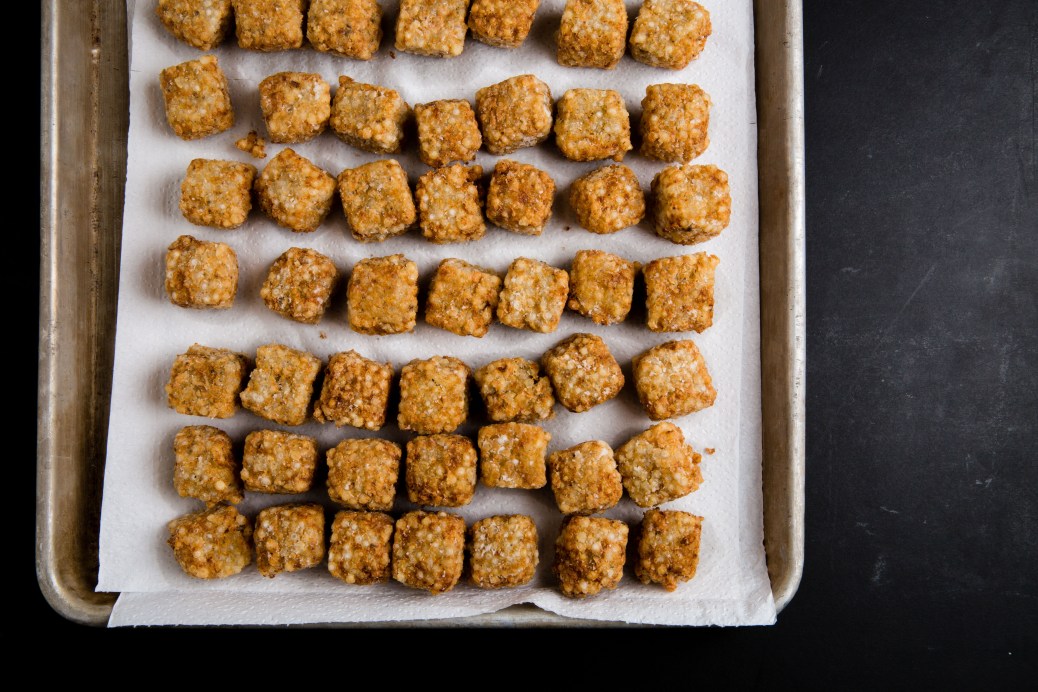Manioc: The Most Important Vegetable You’ve Never Heard Of
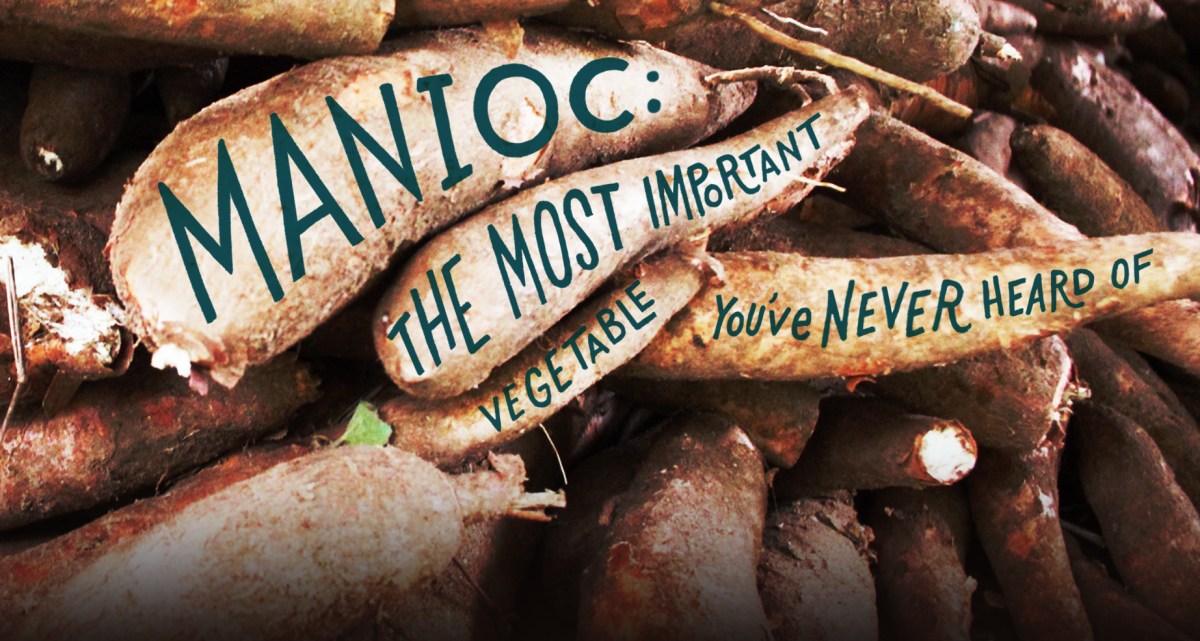
01
Harvest
In the dim shed, warm and swirling with dust, Tobias Behenck crouches to tend the fire burning beneath a large metal saucer, in which a fresh batch of farinha de mandioca is drying. Like a great many Brazilians, Tobias and his brother Paulo, both manioc farmers and millers, eat this coarse manioc meal practically every day for lunch atop their rice and beans. The nutrient-dense dish is so widely eaten in Brazil that its name in Portuguese, arroz e feijão, is also slang for “simple” or “basic.”
Manioc itself—a large, starchy tuber, also called cassava—plays a fundamental role in everyday Brazilian cuisine. In addition to farinha de mandioca, it’s also used to make a manioc starch called polvilho, which can be classified as sour (fermented) or sweet (not) polvilho. In the United States, the sweet polvilho is known as tapioca starch, useful as a thickener and in various other applications in the gluten-free kitchen. It’s used to make tapioca, the essential ingredient in many a Midwestern pudding, as well as the gooey, tender tapioca balls at the bottom of your bubble tea.
Today, the Food and Agriculture Organization of the United Nations estimates that manioc is the primary food staple for around 800 million people, with more than half the world’s annual production, now around 260 million tons, in Africa. Nigeria is, by a long shot, the world’s leading producer, with Brazil, Thailand, and Indonesia duking it out for a distant second. But, despite the fact that manioc is Brazil’s most important contribution to the global food supply, this remarkably versatile ingredient remains relatively unknown outside the tropics.
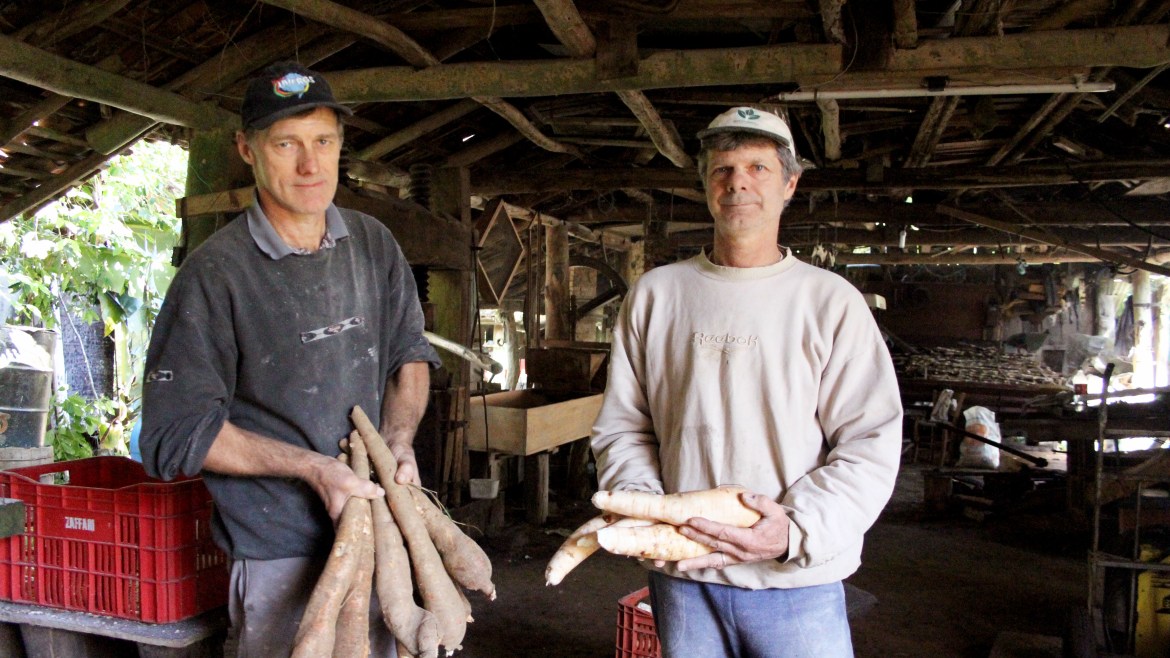
It’s a sunny, gentle June day, the height of the midwinter manioc harvest in southern Brazil. Every year at this time, the Behencks fire up their simple mill to make another year’s supply of farinha, using essentially the same techniques employed for generations on their farm in the rural coastal community of Três Cachoeiras.
Their work begins out in the field, where a good, firm tug at the base of a manioc plant’s woody stalk is sufficient to uproot it. A couple of hacks with a machete frees the long roots, which are similar in size, shape, and appearance to an enormous parsnip. Their truck bed fits roughly a metric ton. They fill it after four hours of gathering manioc. Then, it’s off to the processing shed.
There, the first step is a spinning, water-spraying cylindrical drum that washes the roots and removes most of the peel. Next, comes quality control with a simple kitchen knife: Tough ends and ugly spots are chopped off; stubborn bits of peel and dirt are removed from nooks and crannies. After a grater reduces everything to a ground wet mess, it’s time for the press, featuring huge, black wooden screws made from ipê, a Brazilian tree with exceptionally hard wood.
Using a long stick for leverage, Paulo torques the ipê screws tight to squeeze moisture from the ground manioc. The brothers collect the cloudy white runoff to fertilize their banana patch. There’s a little bit of everything on the Behenck farm—fruits, vegetables, livestock, bees. Paulo guesses that 90 percent of their food comes directly from the farm. Subsistence is their first priority; they sell what they don’t need at a nearby market to earn a bit of cash. A kilo of their farinha goes for 5 reals, worth about $1.50. It’s organic, save for the official certification. As is the case in the United States, getting the certification would be an expensive, labor-intensive process, beyond the Behencks’ simple needs or ambitions.
After 12 hours in the press, the meal comes out in dense, crumbly cakes, ready for final drying above the fire. As a wooden paddle slowly sweeps around the metal saucer, keeping the farinha from burning, Tobias reaches in to sample a pinch. Using his sense of smell and taste to tell that it’s done, he rakes the hot meal off the dryer and scrapes most of it into a bin. The little bit that remains goes perfectly with juicy sections of tangerine picked from the tree out back—one of the simple pleasures of farm life.
The farinha coming hot off the Behencks’ drying pan—just one of several ways in which manioc is commonly processed—is a workhorse in the Brazilian kitchen, used to thicken soups, fortify broths, sprinkle on meat, and give your everyday plate of rice and beans a cheap, energy-rich kick in the pants. You’ll find farinha in pirão de peixe, a fish stew from the northeast, as well as virado à paulista, a bean dish that fed the far-roaming, fortune-seeking, slave-hunting bandeirantes from colonial São Paulo. You mix it into barreado, a slow-cooked, Azorean-inspired beef stew from southern Brazil. You fry it up with butter or palm oil and bits of whatever catches your fancy—meat, veggies, eggs, spices—to make farofa, a side dish eaten all over the country.
“The whole gastronomy of Brazil is based on manioc,” says Teresa Corção, a well-known chef and Slow Food activist from Rio de Janeiro. “But because it’s considered poor people’s food, many people haven’t paid attention to it.”
Up in the rafters above the two brothers and their farinha-coated tangerines hangs an old yoke, covered in cobwebs and fine manioc dust. It’s a memento from decades past, when the brothers were boys and the paddle whirling in the drying pan was hitched to an ox. Though they’ve since upgraded to an electric motor, the overall process has changed little from generation to generation. The very same press has been putting the squeeze on freshly ground manioc since at least when the Behencks’ granddad ran the place. Maybe it’s been longer than that. They’re not quite sure.
Instead, here in Três Cachoeiras, change is evident in what you don’t see. Rural Brazil, rural America, rural wherever: The young wander off toward bright lights and big cities; the competition industrializes; the food safety regulators issue increasingly cumbersome edicts from the comfort of their distant offices.
“There’s just a few of us now,” says Paulo. “Every year [another small mill] shuts down.”
02
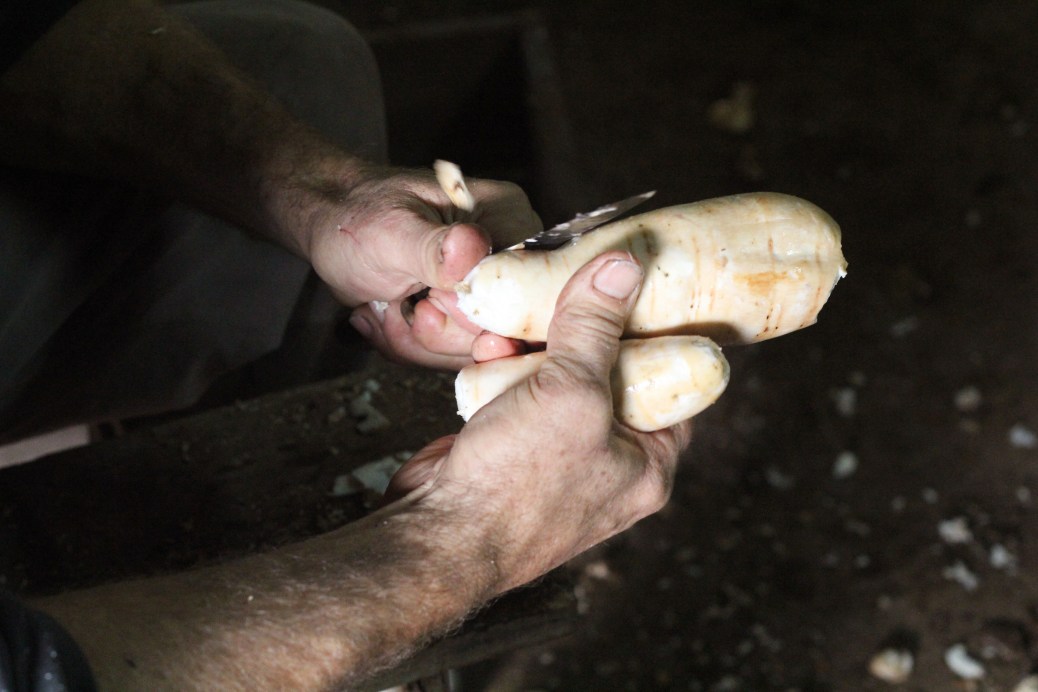
The Origins of Manioc
Manioc is one of Brazil’s gifts to human sustenance. An oft-retold indigenous legend traces the plant’s origins back to the tragic death of a young girl named Mani. Her grieving grandfather, a chief, buries the girl in his house, and her stricken mother waters the grave every day, until, suddenly, a strange new plant with sweet, pale roots bursts from the ground. Manioc—mandioca in Portuguese— is derived from the Tupi for “house of Mani.”
A more rigorously scientific creation story points to what is modern-day Brazil, where humans likely first cultivated manioc many thousands of years ago (dates in the literature vary considerably). Regardless, manioc was widely grown in South and Central America and the Caribbean by the time of European contact. Before long, Portuguese colonists had incorporated manioc into their diets in place of wheat, which didn’t grow well in Brazil’s tropical climate. The African slaves the Portuguese brought here in staggering numbers also adapted manioc to their own traditional dishes. Today, manioc features prominently across Brazil’s varied regional cuisines and epitomizes the ways in which indigenous, African, and European influences have combined to shape Brazilian culture over the past 500 years.
03

Go Starchy
Farinha is not the only Brazilian staple that comes from manioc. Another major one is polvilho, the pure, white starch that’s rinsed from the roots and used traditionally for baking—best exemplified by pão de queijo, the cheesy pastry that’s become one of Brazil’s favorite snacks.
The first steps in polvilho production are similar to what happens in the Behencks’ farinha shed: the tubers are husked, washed, and ground into a sticky paste. Then comes the rinse, where water gushing through the ground manioc washes the starch into a holding tank. After the starch settles to the bottom, the rinse water gets poured off, the starch gets dried, and you have what’s known in Brazil as polvilho doce, or sweet starch.
In colonial Brazil, Portuguese settlers turned to manioc starch to replace wheat because wheat wouldn’t grow. Much more recently, people all over the world have begun replacing wheat with manioc starch because it’s a wonderful ingredient in gluten-free cooking and baking. In the United States, sweet manioc starch is marketed as tapioca starch or tapioca flour.
“It really has so many versatile, different uses,” says author and food entrepreneur Heather K. Terry, “[but] people don’t really understand the full extent to which they can use it.”
One of its primary characteristics is the gooey texture it develops when mixed into a liquid (think tapioca pudding), and for that, we have the starch’s molecular structure to thank.
“What makes tapioca starch different is that it has a low to medium level of amylose [one of the types of polysaccharides that makes up starch],” says Guy Crosby, science editor for America’s Test Kitchen and adjunct assistant professor at Harvard University’s TH Chan Public School of Health. “And starches with low to medium levels of amylose form weak gels. This is why tapioca starch forms mostly a high-viscosity paste.”
“The molecules in tapioca starch are packed into small, loosely packed granules about the same size as those in cornstarch,” he adds. “This causes tapioca starch to gel at lower temperatures than other starches—20 degrees Celsius or 65 degrees Fahrenheit lower.”
That makes tapioca starch an excellent base for things like a gluten-free roux and a popular choice for thickening gluten-free pie fillings and puddings. (The America’s Test Kitchen gluten-free flour blend uses tapioca starch in tandem with other alternative flours.) Gluten-free bakers also value the gooey, stretchy properties of tapioca starch, which can replicate the stretchiness and elasticity that gluten gives conventional baked goods. An additional boon for baking: “Tapioca starch is virtually flavorless,” says Crosby.
04
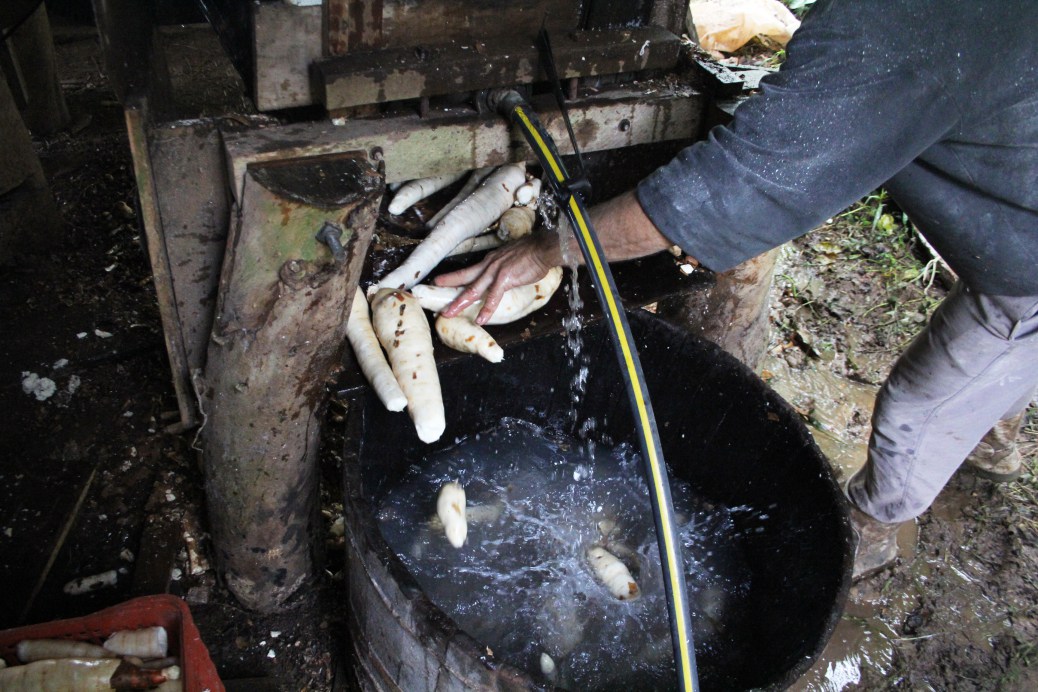
The Dangerous Side of Manioc
The thousands of varieties of manioc that exist are generally separated into two broad groups—the sweet, or table, varieties that can be prepared relatively simply (think: boiled, fried, baked), and the bitter kinds that are generally only edible after processing into a derivative like farinha. The difference between the two involves their varying levels of cyanogenic glucosides, organic compounds that can break down into a nasty little form of cyanide that you don’t want in your food.
These glucosides are present to some degree in all parts of the manioc plant. In the sweet varieties, however, levels inside the roots themselves are low enough to be ignored for practical intents and purposes.
Luckily, manioc has a built-in solution to this cyanide problem. It’s an enzyme called linamarase, which is also present in the roots. This enzyme helps to catalyze reactions involving the glucosides to produce hydrogen cyanide, another nasty little poison best steered clear of. Even though this sounds exactly like what you don’t want happening in your food, it works in our favor because hydrogen cyanide is a volatile gas that readily disperses in air or water. Traditional processing methods in Brazil, typically involving some combination of grinding and soaking, render bitter maniocs safe for consumption by exposing the cyanogenic glucosides to linamarase, with the resulting hydrogen cyanide eventually drifting off into the air or water.
Cyanide-related concerns aside, bitter maniocs are widely grown around the world, in large part because the same cyanogens that require careful handling also keep opportunistic wildlife from raiding the fields. Unfortunately, in some parts of Africa—particularly during dry years when the manioc roots contain higher concentrations of the cyanogenic glucosides because rainwater isn’t available to wash away hydrogen cyanide—inadequate processing techniques can cause serious health problems.
In southern Brazil, where the Behencks farm is located, much (but not all) of the manioc grown is sweet.
05

Ferment It
A few miles north of the Behencks’ simple farinha mill, off the main coastal highway in the little town of São João do Sul, sits a small starch factory called Polvilho Ouro Sol (Golden Sun). You’re likely to notice the sour, fart-like odor of the drying starch before you can see it, spread to dry in blinding white rows on black plastic sheets beneath the sun. The smell is part of the job, chuckles Henrique Borba, the sales manager of the business his family has run for a few decades. Before long, you don’t even notice it anymore.
Noticed or not, the smell is actually a side effect of the fermentation that goes on here at Polvilho Ouro Sol, where instead of the polvilho doce, or sweet manioc starch, they make polvilho azedo, or sour starch. That’s accomplished with one key tweak: after rinsing the starch from the ground manioc roots, the starchy slurry sits in pools to ferment for 60 to 90 days before being spread out to sun-dry.
At a traditional, small-scale outfit like Ouro Sol, the fermentation is primarily a lacto-fermentation process carried out by naturally occurring bacteria that convert the sugars in the starch into lactic acid. Once that’s run its course, and the weather forecast calls for two or three sunny days, the fermented starch is spread out to dry in the sun. When dried, the sour starch has the unique and remarkable characteristic of expanding during baking without the help of yeast, baking soda, or any other leavening agent.
Though food scientists are still untangling the exact mechanisms by which this unique transformation occurs, it appears that the lactic acid produced during fermentation breaks down the polysaccharide chains that make up the starch granules. Exposure to ultraviolet light during the sun-drying process further modifies the structure of these chains.
“In studies, scientists have hypothesized that with sunlight and air, the starch molecules go through a bit of oxidation and develop acid groups,” says Crosby. “These acid groups give the starch unusual properties—giving it more structure, and more gas holding ability, as well as a bit more gumminess and elasticity.”
This expansive property makes sour starch an ideal companion to the sweet starch in something like the pão de queijo, says Raquel Zucchi of AMOA Bakery, a vegan, gluten-free bakery in Porto Alegre, Brazil. When used together in the recipe, the sweet starch gives the pastry a desirable stretchiness, while the sour adds a satisfying poof and crunch.
“You have to use both starches,” says Zucchi. “Each one has its function.”
In addition to pão de queijo, sour starch is used to make other snacky foods like the crunchy, airy biscoito de polvilho, which have the density and textural appeal of Cheetos.
06
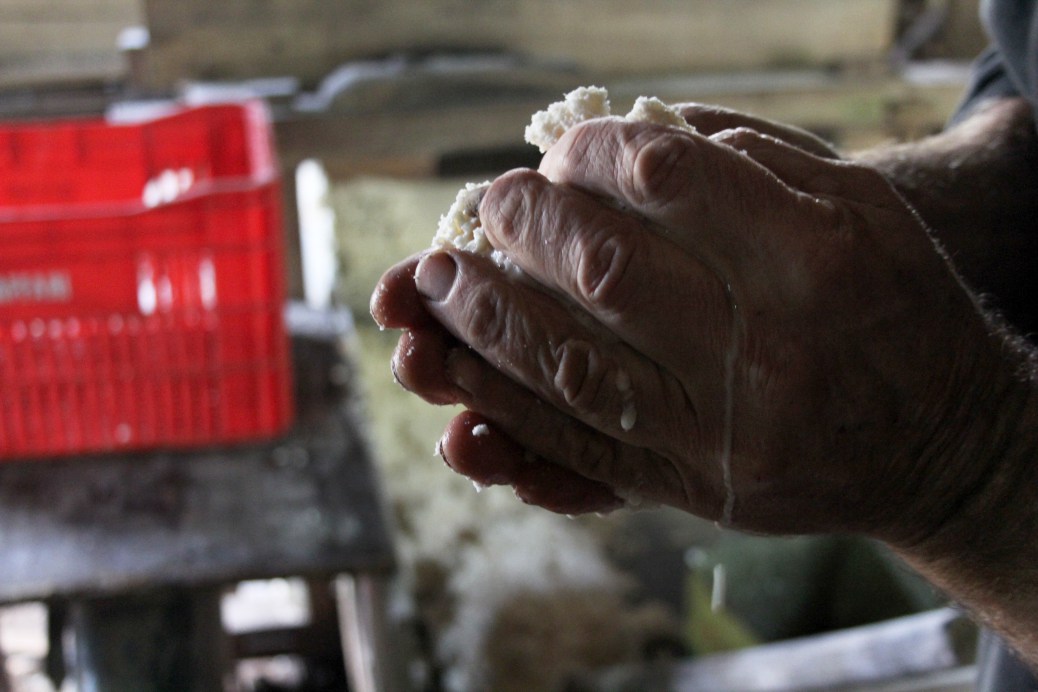
Planting Time
The rhythms of life on the Behenck farm move with the seasons. By late July, manioc harvesting and milling has given way to cutting sugarcane and refining it into sugar. The manioc press has been disassembled and cleaned and the stirring paddle idled for another long off-season. The old yoke still dangles up above. When spring rolls around in September, it’ll be time to plant another manioc crop. It’s an easy process. A small piece of stem stuck down into the soil in the springtime will be a mature plant by midwinter, the following June. It’s a cycle that’s been feeding people in this part of the world since more or less forever, a crop that’s since colonized much of the world, and a food that, depending on your latitude, you may eat every day—or may have never heard of.
07
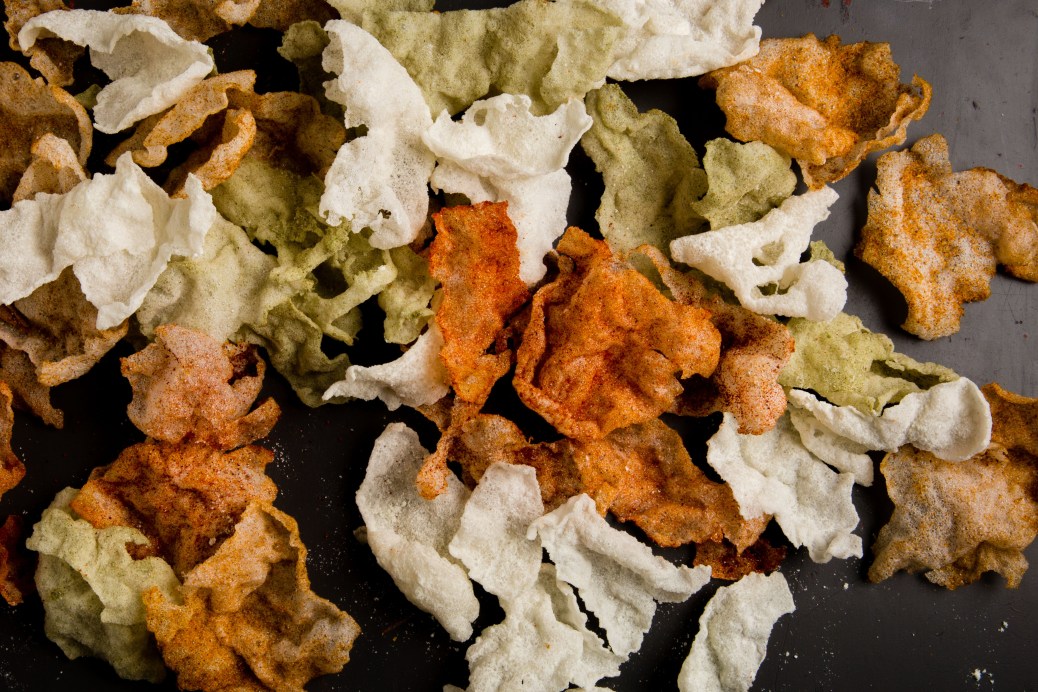
Back to the Test Kitchen
[Ed note: After Andrew Jenner delivered his manioc story to the Cook’s Science team, test cook Sasha Marx began developing his own recipes for the home cook. The following is from his perspective.]
This manioc project was the first thing I worked on upon joining the team at Cook’s Science and America’s Test Kitchen. Executive Editor Dan Souza had emailed me while I was wrapping up my time as a sous chef at Parachute Restaurant in Chicago to tell me about the story, and he wanted to know if I had any experience working with tapioca starch, the dried extract derived from the manioc root. It just so happened that John Clark, one of the chef-owners at Parachute, had spent a good deal of time in Puerto Rico, where tapioca starch is a common ingredient, and I had been exposed to a few different cooking techniques using the product. Despite its popularity abroad, tapioca starch is not a product that we encounter very often here in the United States, outside of bubble tea and your grandmother’s favorite pudding. We decided we wanted to develop a few recipes that would highlight the versatile and unique properties of this ingredient.
By my second day at America’s Test Kitchen, I was deep in tapioca world. My first challenge was to develop a recipe for a popular Brazilian snack, pão de queijo, or cheese bread. I had no familiarity with this bread, minus photos and emails from Andrew Jenner (plus Dan’s rave reviews), describing it as a fist-size roll, reminiscent in flavor to a French gougère, but made with tapioca starch instead of wheat flour. In my initial tests, I took the gougère comparison quite literally and worked off of recipes that yielded small passed-appetizer-size cheese puffs that were tasty, but didn’t have the heft that we were looking for. I decided to bring some legit pão de queijo back to the test kitchen from a local Brazilian bakery. The bakery rolls revealed how misleading the gougère comparison was. Unlike the light, airy, and hollow pâte à choux French cheese puff, the interior of Brazilian cheese bread is denser, with a gooey and stretchy center. This texture is a direct result of the tapioca starch, which forms a viscous paste, rather than any kind of gluten network. (In other words, pão de queijo is one of the tastiest gluten-free baked goods I had ever tried. Full disclosure: That’s not saying much. Shots fired.) I had to recalibrate my approach.
As I increased the size of the rolls I began to run into problems with the interior texture of the bread. Even when I accounted for increased baking time due to increased size, the cheese bread ate like a pasty gut bomb. The center of the rolls had an unappealing greasy, gooey texture that led us to believe that the hydration levels in the dough were off-balance and needed to be adjusted. I ran some calculations and discovered that most recipes I found for pão de queijo had a hydration level well over 100 percent, which is more of a batter than a dough. I began tinkering with that percentage to see if we could bring it down to bread levels, eventually settling on a dough with 91 percent hydration. By removing water, we were able to produce a roll that had more intense cheese flavor and an interior that was lighter and pleasantly gooey. Whether you’re gluten-free or not, these will fly off the table at your next brunch.
The other two recipes in my tapioca set involve cooking methods I picked up from John Clark that show off a little technique while not being so difficult as to discourage someone from trying them at home. The puffed tapioca chips are a really cool alternative to potato chips or popcorn, and can be flavored in a million different ways. The water trapped in the tapioca starch during the initial cooking process turns to steam when the chips are fried in hot oil, and that rapid expansion causes them to puff beautifully. The fried cacio e pepe bites are another inventive snack that skirt the lines of definition between croquettes and arancini. For these, we use the same type of tapioca that goes into pudding: tapioca pearls, which are small spheres of tapioca starch granules held together by a matrix of gelatinized tapioca starch. For this recipe, the tapioca pearls take the place of the Arborio rice commonly used in arancini, and provide a unique chewy, textured quality. With no breading required, these bites are the gluten-free answer to your game day party needs. While tapioca can be integrated with flavors that are quite familiar, its textural qualities are wildly different from anything I was used to, and I feel that these recipes do a great job showing that.
An earlier version of this article stated that most pão de queijo recipes have a 40 percent hydration level, while our final recipe had a 30 percent hydration level. In fact, most recipes contain a hydration level over 100 percent, while our final recipe has a hydration level of 91 percent. We regret the error.
Field photography by Andrew Jenner.
Test Kitchen photography by Steve Klise.
08
